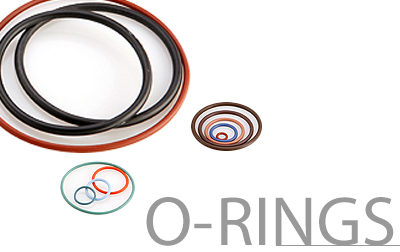Understanding O-Rings: Essential Sealing Solutions for Modern Industries #
O-rings, sometimes referred to as donut gaskets or toroidal seals, are fundamental components in sealing technology. Their simple yet effective design allows them to create a reliable barrier against leaks and contamination across a wide spectrum of industries. By forming a tight seal between two mating surfaces, O-rings prevent the passage of fluids or gases while maintaining the flexibility needed for movement and pressure changes.

Applications of O-Rings #
O-rings are integral to a variety of engineering and industrial applications, including:
- Automotive: Sealing components in engines, transmissions, and hydraulic systems.
- Aerospace: Maintaining pressure integrity in aircraft engines, fuel systems, and life support equipment.
- Petrochemical: Ensuring leak-proof connections in pipelines, valves, and processing equipment.
- Hydraulic and Pneumatic Systems: Providing reliable sealing in fluid power systems for industrial machinery.
- Chemical Industry: Preventing chemical leaks and protecting against corrosion in processing equipment.
- Food Industry: Maintaining hygiene and preventing contamination in food processing machinery and packaging.
Key Advantages of O-Rings #
O-rings offer several benefits that make them a preferred choice for sealing applications:
- Simple and Effective Design: Minimal installation requirements and straightforward operation.
- Versatility: Customizable in size, material, and hardness (durometer) to suit diverse environments.
- Durability: Manufactured from resilient rubber compounds, O-rings withstand harsh conditions and repeated use.
- Cost-Effectiveness: An economical solution compared to alternative sealing methods.
Material Options for O-Rings #
Selecting the right material is crucial for optimal performance. Common O-ring materials include:
- Nitrile (NBR): Versatile and widely used for general applications, offering resistance to oils, fuels, and solvents.
- Ethylene Propylene Diene Monomer (EPDM): Exceptional resistance to ozone, weather, and hot water, ideal for outdoor and automotive uses.
- Fluorocarbon (FKM): Excellent resistance to extreme temperatures, high pressures, and aggressive chemicals, suitable for demanding petrochemical and aerospace applications.
- Silicone (VMQ): High temperature resistance, food-grade compatibility, and resistance to compression set, making it suitable for food processing and pharmaceutical industries.
Custom O-Ring Materials and Applications #
Lian Yu provides a broad selection of custom O-ring materials to address specific application requirements. Our team assists in material selection based on:
- Operating Temperature Range: Ensuring the material can withstand expected temperatures.
- Chemical Compatibility: Matching the O-ring material to the fluids or gases it will encounter.
- Hardness Requirements: Selecting the appropriate durometer for the sealing application.
We also specialize in designing and manufacturing custom O-rings for unique needs, including non-standard sizes, specific material formulations, and specialized groove designs. Our collaborative approach ensures tailored solutions for every customer.
Guidelines for Choosing Custom O-Rings #
To select the most suitable custom O-ring, consider the following factors:
- Application Requirements: Define operating conditions such as temperature, pressure, chemical exposure, and desired sealing performance.
- Material Selection: Choose materials based on compatibility, temperature resistance, and hardness.
- Size and Dimensions: Accurately measure groove dimensions and specify the required inner diameter and cross-section.
- Tolerance Requirements: Set acceptable tolerance levels for dimensions and durometer to ensure proper fit and function.
- Surface Finish: Specify surface finish (smooth or textured) to optimize sealing effectiveness and minimize wear.
Proper Care and Maintenance of O-Rings #
Maintaining O-ring performance involves:
- Storing O-rings in a clean, dry environment.
- Protecting them from extreme temperatures and chemicals.
- Avoiding excessive flexing or stretching.
- Replacing any O-rings that show signs of damage or wear.
O-Ring Standards #
Lian Yu’s O-rings are manufactured to meet or exceed recognized industry standards, including:
- ASTM D2000: Standard Specification for O-rings
- SAE AS568: Standard for O-rings and Seals
- DIN 3771: Standard for O-rings
- ISO 3601: Standard for O-rings
For more information or to discuss your specific sealing requirements, contact us. Our team is ready to assist you in selecting and customizing O-rings to meet your application’s needs.